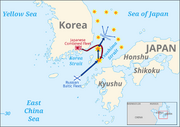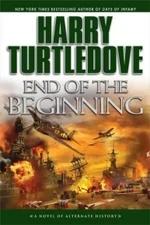| Battle of Tsushima | |||||||
|---|---|---|---|---|---|---|---|
| Part of the Russo-Japanese War | |||||||
|
|||||||
| Belligerents | |||||||
| Commanders and leaders | |||||||
| Strength | |||||||
| 4 battleships 27 cruisers 21 destroyers 37 torpedo boats plus gunboats, and auxiliary vessels total:89 ships | 8 battleships 3 coastal battleships 8 cruisers 9 destroyers total:27 ships |
||||||
| Casualties and losses | |||||||
| 117 dead 583 injured 3 torpedo boats sunk | 4,380 dead 5,917 captured 21 ships sunk (7 battleships) 7 captured 6 disarmed |
||||||

The Battle of Tsushima was the last and most decisive sea battle of the Russo-Japanese War of 1904–1905. It was fought on May 27–28, 1905 in the Tsushima Strait. In this battle the Japanese fleet under Admiral Heihachiro Togo destroyed two-thirds of the Russian fleet under Admiral Zinovy Rozhestvensky. It was the largest and only major naval engagement fought by pre-dreadnought battleships, and the only sea battle in history in which steel battleships fought a decisive fleet action.
Historian Edmund Morris calls it the greatest naval battle since the British victory over the French and Spanish at Trafalgar, 100 years earlier.
Battle of Tsushima in Days of Infamy[]
Fleet Admiral Isoroku Yamamoto had taken part in the Battle of Tsushima, losing the first two fingers of his left hand. During the war with the United States, he constantly fought for a decisive battle, one reminiscent of the Battle of Tsushima in order to finally force the United States to the negotiating table. Alas, he nor any other fleet commander was able to do this. Even the invasion and conquest of Hawaii, which was costly to both sides, did not definitively vanquish the U.S.
See also[]
- Battle of Tsushima (1896) at the Leviathans wiki, a fictional battle which is briefly alluded to in "Last Flight of the Swan of the East."
| |||||||||||||||||

